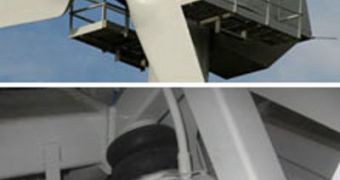A Canadian company may have developed a prototype for a new generation of wind turbines. Rather than relying on complex gearboxes to convert wind energy into electricity, the new design, of which a scale model has already been built, makes use of friction forces to do exactly the same thing. The innovation, if applicable, could translate into a new class of turbines that will endure for longer, and that will not need to be shut down for several days each year, for maintenance. This will increase the power output, and will also save the world of hundreds of tonnes of carbon dioxide each year.
The company, Owen Sound, Ontario-based CWind, has already started working on a larger, two-megawatt prototype, which it hopes to be able to test soon, Technology Review reports. The new “friction drive,” as experts at the company call it, runs more efficiently and reliably than existing devices, and also promises numerous financial saves. In regular wind turbines, the gearboxes are highly complex mechanisms, which require a lot of time and money to repair, in case of a failure. Scientists around the world have been looking for methods of mitigating this flaw for quite some time now.
Unlike a conventional turbine, in which the blades are connected to a shaft that drives a generator, the new design does away with all of the gearbox – which is also the heaviest part of a conventional wind “harvester.” The approach uses a shaft to propel a large metal flywheel inside the nacela – the upper part of the turbine. The flywheel is surrounded by eight smaller, secondary shafts, which are in turn connected to eight 250-kilowatt generators. Each of the secondary shafts is covered with special tires, which grip onto the surface of the flywheel. “We're using friction. It's not mechanically hard-coupled,” CWind engineer and co-inventor of the system Na'al Nayef explains.
If the wind suddenly speeds up, which is the main cause why gearboxes fail, the tires simply slip from the surface of the flywheel, preventing any damage to the ensemble. In conventional turbines, sudden gusts of wind place the mechanical devices inside under tremendous stress, and cause them to fall apart. “We can operate the generators at optimal speed all the time,” Nayef says. The expert also reveals that the small-scale model featuring the new design also showed a five-percent increase in efficiency from similarly sized, conventional wind turbines.

 14 DAY TRIAL //
14 DAY TRIAL //